The Best Fluffy Comforters

In the past, comforters were associated with bedding items suitable for the cold season. People would often choose them because of their high insulation capabilities and immense fill power, as they could trap heat underneath them and make even the coldest sleeper feel warm. Today, comforters come in all shapes and sizes, and there are even models that you can use throughout the entire year. However, fluffy comforters have always had a generous fanbase, so today’s article is dedicated to helping you find the best ones.
| Rank | Product |
| #1 | 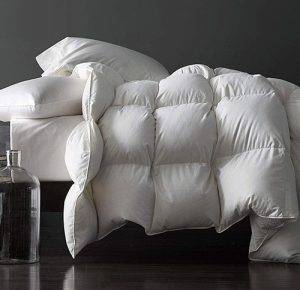 Royoliving Premium Heavyweight Silver Down Comforter Royoliving Premium Heavyweight Silver Down Comforter
|
| #2 | 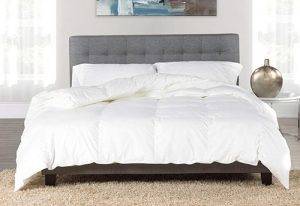 WESTEX Comforter WESTEX Comforter
|
| #3 | 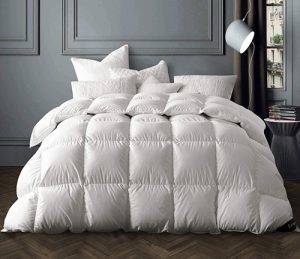 Globon Winter White Goose Down Comforter Globon Winter White Goose Down Comforter
|
| #4 | 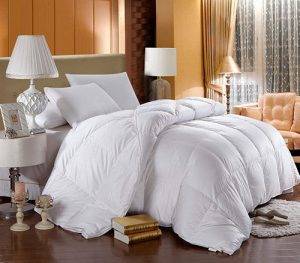 Royal Bedding Comforter Royal Bedding Comforter
|
| #5 | 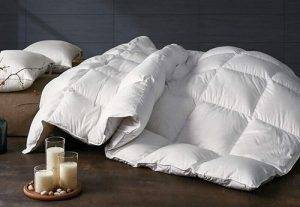 APSMILE Heavyweight Goose Down Comforter APSMILE Heavyweight Goose Down Comforter
|
Table Of Contents
- What Is Inside a Comforter?
- What Is Fill Power?
- What Is Thread Count?
- Does Stitching Matter?
- Best Fluffy Comforters
- 1. Royoliving Premium Heavyweight Silver Down Comforter
- 2. WESTEX Comforter
- 3. Globon Winter White Goose Down Comforter
- 4. Royal Bedding Comforter
- 5. APSMILE Heavyweight Goose Down Comforter
- Conclusion
What Is Inside a Comforter?
Referred to as “fill”, the materials inside the comforter have a direct impact on the warmth level of a product. With multiple options on the market, we can label fill as falling into one of three main categories: natural down, down alternative, and other materials:
Natural down comforters are filled with goose or duck down. Goose down is believed to be more efficient because the birds it is sourced from are larger. Goose down comforters tend to be more expensive because they are luxurious and offer more warmth. Duck down comforters offer a good loft and plenty of warmth, but the fill is lighter in weight and less expensive compared to goose down.
Down alternative comforters are made from polyester microfibers, but they are often just as soft and offer as much loft as those made from natural down. Down alternative is often the choice of many people because it’s less expensive and the fill doesn’t trigger any allergies, as opposed to natural down products. However, it’s important to mention that not all down alternative fill is of the same quality. Generally speaking, comforters that are made with gel-fiber and Primaloft fill are considered to be of higher quality and are a much more durable choice, even if they cost more.
Other materials that can be used to make up the fill of a comforter are cotton (low-cost options, typically provides a decent amount of warmth), wool (very warm, especially during the winter, and also offers breathability and moisture-wicking capacity, even if they are heavier), and silk (this fill is luxurious, lightweight and soft, but it isn’t as warm as some of the other options, which is why it’s preferred in the construction of summer comforters).
What Is Fill Power?
Fill power is a measurement of how much fill a comforter has and how well it can insulate during different seasons throughout the year. It’s important to mention that natural and alternative down comforters are the only ones that have fill power, and it measures how much volume is in a single ounce of down. If you notice that a comforter has a lot of fill power, it means that the fill has more volume and can trap heat underneath in a more efficient manner.
There are several things that can impact the fill power of a comforter, including the exact bird it came from, its maturity, and whether the fill is formed from clusters or features.
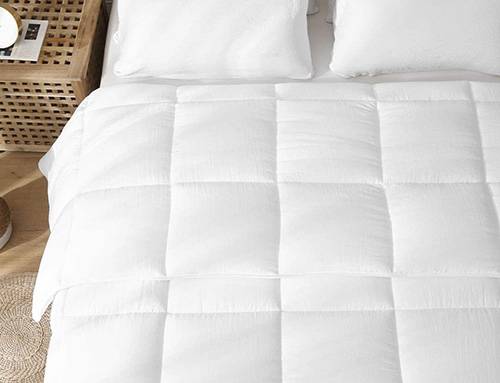
A comforter with a fill power lower than 400 doesn’t have a lot of loft, which means that it won’t keep you very warm. Comforters with fill power between 400 and 599 are warmer than the last option, but aren’t usually enough to get you through the winter. What you want during cold seasons is a comforter with a fill power between 600 and 799. This can serve as an all-season comforter, but also provides enough insulation to keep you warm during the winter. For those of you that live in really old areas, we recommend comforters with at least 800 fill power. These are made with dense down feathers and clusters, they are extremely fluffy, and have plenty of loft, but they are also more expensive.
What Is Thread Count?
Thread count is often considered to be a measure of quality when it comes to the fabric that’s used to make the cover of the comforter. Thread count is merely a measurement that indicates the yarn’s density for every square inch of fabric. Fabrics that have higher thread counts are considered to be softer and more durable. However, there are plenty of brands out there that take advantage of the popularity of high thread counts and claim that their products have up to a thousand TC, which is simply not true.
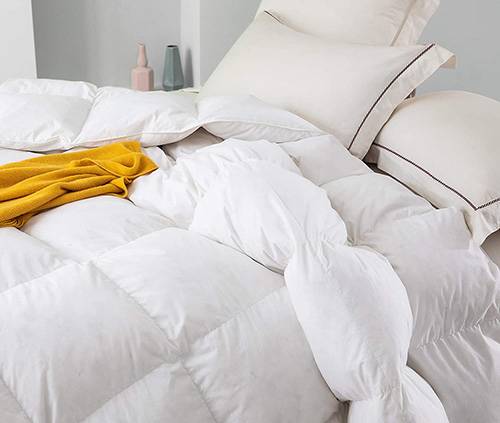
Most comforter shells will do just fine with 300 or 400 thread count. The surface of such a fabric should be smooth enough and perfectly capable of keeping the fill inside of the comforter. Comforters that have a thread count between 400 and 500 usually have a tighter weave, which translates into further durability.
When you look at comforters with a cover that has a thread count between 500 and 800, while it might be tempting to buy it, you should know there isn’t any significant difference between them and the previous category. Same goes for those with a thread count higher than 800. These products typically have higher thread counts because they use two-ply yarns in the weaving, which doesn’t bring significant improvement to the feel and durability of the fabric.
Does Stitching Matter?
Stitching plays an important part in the construction of a comforter because it will help determine its quality, its efficiency in terms of insulation, and how easy or difficult it will be to care for it. There are four common stitching styles that you’re bound to encounter when looking at comforters:
Gusseted comforters have the top and bottom sides sewn together at the edges using an extra fabric strip. With a gusseted stitch, the fill inside the comforter can expand upwards. This means that fill will be evenly distributed while ensuring that the comforter has plenty of loft.
Diamond-quilted comforters have a diamond-shaped stitch that unites the top and the bottom of the comforter, making sure that the fill is evenly distributed inside. The role of this type of stitch is to keep the fill in one place. As you know, when the fill shifts too much inside the comforter, you are likely to end up feeling cold spots.
Sewn-through comforters are described by the top and bottom side being sewn together to create chambers that hold an equal amount of fill. This particular stitching pattern means that the fill isn’t allowed to move much, so no that much fill is needed. That, of course, also means that these comforters won’t maintain wealth for very long.
Baffle stitching means that the comforter is made from compartments designed to hold the fill, whilst a separate material piece connects the top and bottom side. The fill will have enough space to move inside the compartments, which means that these comforters have higher loft, even if they so require more frequent fluffing.
Best Fluffy Comforters
1. Royoliving Premium Heavyweight Silver Down Comforter
One of our favorite fluffy comforters is the heavyweight version of the Royoliving line of comforters. Made with a cover that brings forth the very best Egyptian cotton, there is so much more to appreciate about this product than just the rewarding fluffiness and loft. There are multiple versions of this comforter, including an all-season model, and a lightweight one. However, when you want to benefit from a true comforter, you have to choose the heavyweight winter one.
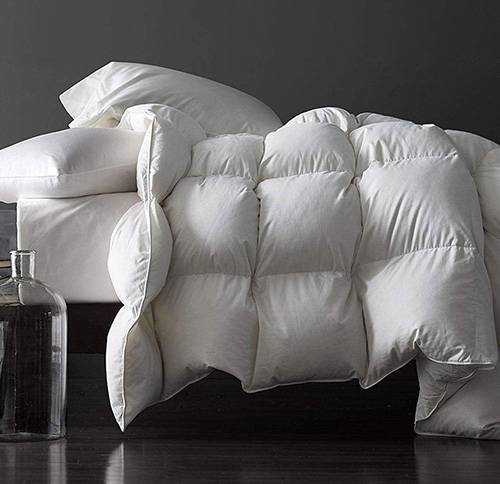
Filled with imported Polish down, this comforter promises to offer a lot of insulation while making sure the comforter is safe as you switch between positions. The manufacturer takes pride in how these comforters are made, ensuring the buyers that every bit of collected down is used to make the final product within six hours, making sure that the fill is not exposed to moisture and doesn’t breed bacteria. There are eight duvet loops to make it easy for you to place the comforter inside a cover. The box-stitch construction is here to make sure that the fill is kept in place.
2. WESTEX Comforter
Another fluffy comforter that we want to talk to you about comes from WESTEX. Considered to be one of the best goose downs on the market, Hutterite down comes from mature birds raised in western Canadian regions. They are famous for having geese with large clusters, which automatically translates into fluffier comforters with more loft. The baffle box construction is here to make sure that you actually benefit from that fluffiness you crave for.
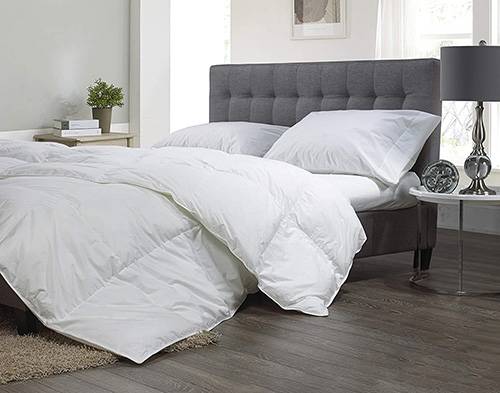
This particular comforter uses Ultra-Fresh antimicrobial technology. What this means is that the product is created using additives that help inhibit the growth of bacteria, fungi, mold, and mildew, making sure that the comforter stays fresh and clean for as long as possible. The product is covered in a shell made entirely out of combed cotton and offers a thread count of 400, which indicates a quality weave and a durable construction. As for the fill power, you get 675 of it, resulting in proper insulation even for colder winter months.
3. Globon Winter White Goose Down Comforter
The Globon comforter is another trustworthy winter companion for each and every one of you that wants to turn down the thermostat at night without worrying about the room being too cold. The fill consists of nano-treated white goose down, ensuring all of us that it dries quickly after washing and is hypoallergenic, meaning it won’t trigger any allergic reaction.
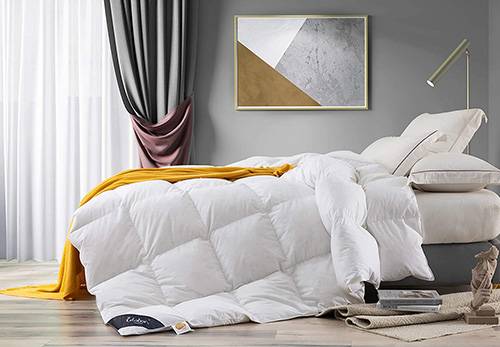
The cover of the Globon comforter is made from sateen weave cotton, offering a thread count of 400 to rely on soft softness and durability. The manufacturer informs us that the fabric has been treated to make sure it’s downproof, which is why it’s super important to take into account all the care instructions in order to prevent damaging the fabric too soon. With a baffle box design, this comforter will keep you warm during the winter, thanks to its 700 fill power that offers generous insulation.
4. Royal Bedding Comforter
As one of the most appreciated products in its category, the Royal Bedding comforter is considered a premium product available in all the standard bed sizes. This is a comforter with 750 fill power, so it’s definitely the ally you want during a cold winter night. The cover is made entirely out of cotton and sports a thread count of 500, which is an indicator of softness and durability, as we mentioned in the first half of the article.
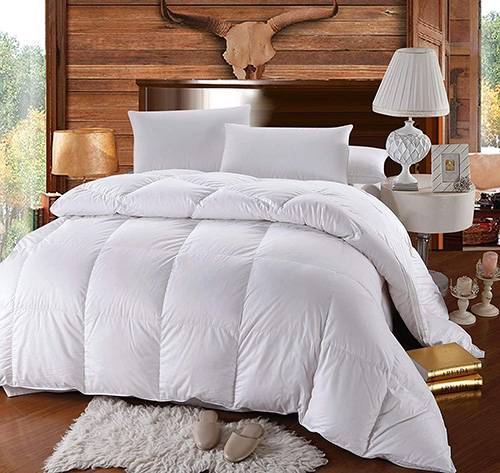
While the comforter has a baffle box design which ensures the fill doesn’t shift inside as you switch position, it also comes with gusset edges (check out the first half of the article to learn more about what gusset edges can do). Although the comforter is filled with natural down, we are not given too much information about the source. We do know that it promises a hypoallergenic construction that will surely be a relief to those that suffer from allergies.
5. APSMILE Heavyweight Goose Down Comforter
The APSMILE comforter is another down product you can rely on. It is a heavyweight product designed for those looking for that warm and cozy feeling of being protected by a comforter that keeps you warm in spite of the cooler temperature inside the bedroom. It comes with a cover that’s made from Egyptian cotton. The 400 thread count is more than enough to provide you with a fabric that feels soft to the touch and also creates an impenetrable barrier that holds the fill inside the product.
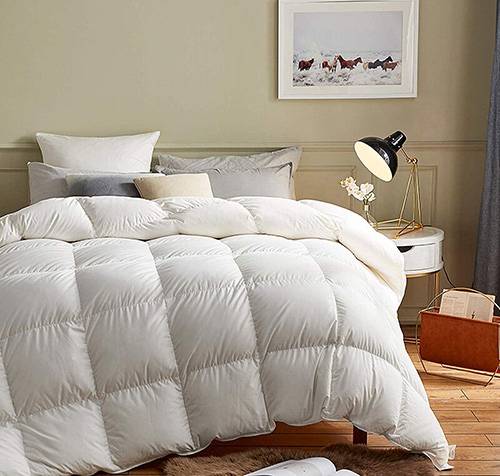
The fill consists of white down that has been responsibly sourced, offering 750 fill power for those of you that never want to experience literal midnight chills. There are eight corner tabs that will make sure putting the comforter inside a cover isn’t any trouble at all. The comforter is hypoallergenic, and meets the OEKO-TEX Standard 100.
Conclusion
Shopping for a fluffy comforter shouldn’t be all that complicated once you understand what makes a good comforter in the first place. Fluffy comforters aren’t really needed if you plan on using them during the summer, but they can make great sleeping companions in the winter. It’s also important to understand that there several factors that will determine the quality of a comforter, including the stitching, the fill power, but also the materials that are used to make the comforter and its cover.
Photo credit: Yuttana Jaowattana/Shutterstock

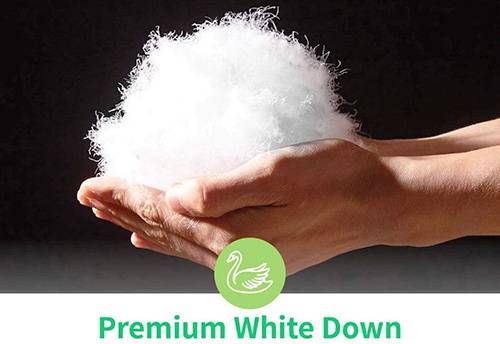 Natural down comforters are filled with goose or duck down. Goose down is believed to be more efficient because the birds it is sourced from are larger.
Natural down comforters are filled with goose or duck down. Goose down is believed to be more efficient because the birds it is sourced from are larger. 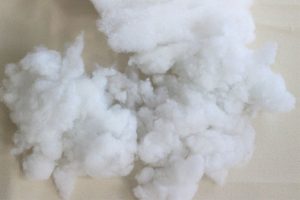
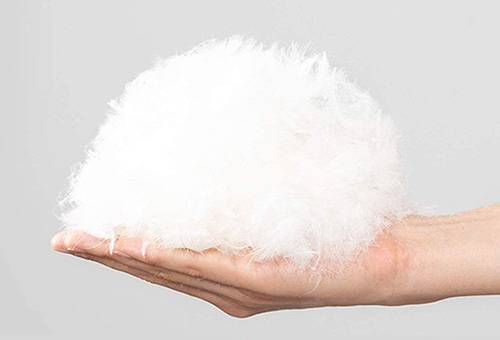 Other materials that can be used to make up the fill of a comforter are cotton (low-cost options, typically provides a decent amount of warmth), wool (very warm, especially during the winter, and also offers breathability and moisture-wicking capacity, even if they are heavier), and silk (this fill is luxurious, lightweight and soft, but it isn’t as warm as some of the other options, which is why it’s preferred in the construction of summer comforters).
Other materials that can be used to make up the fill of a comforter are cotton (low-cost options, typically provides a decent amount of warmth), wool (very warm, especially during the winter, and also offers breathability and moisture-wicking capacity, even if they are heavier), and silk (this fill is luxurious, lightweight and soft, but it isn’t as warm as some of the other options, which is why it’s preferred in the construction of summer comforters).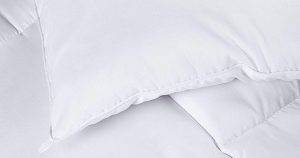 Gusseted comforters have the top and bottom sides sewn together at the edges using an extra fabric strip. With a gusseted stitch, the fill inside the comforter can expand upwards. This means that fill will be evenly distributed while ensuring that the comforter has plenty of loft.
Gusseted comforters have the top and bottom sides sewn together at the edges using an extra fabric strip. With a gusseted stitch, the fill inside the comforter can expand upwards. This means that fill will be evenly distributed while ensuring that the comforter has plenty of loft.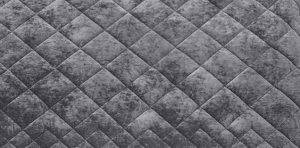 Diamond-quilted comforters have a diamond-shaped stitch that unites the top and the bottom of the comforter, making sure that the fill is evenly distributed inside. The role of this type of stitch is to keep the fill in one place. As you know, when the fill shifts too much inside the comforter, you are likely to end up feeling cold spots.
Diamond-quilted comforters have a diamond-shaped stitch that unites the top and the bottom of the comforter, making sure that the fill is evenly distributed inside. The role of this type of stitch is to keep the fill in one place. As you know, when the fill shifts too much inside the comforter, you are likely to end up feeling cold spots.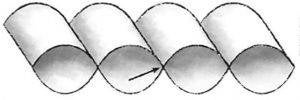 Sewn-through comforters are described by the top and bottom side being sewn together to create chambers that hold an equal amount of fill. This particular stitching pattern means that the fill isn’t allowed to move much, so no that much fill is needed. That, of course, also means that these comforters won’t maintain wealth for very long.
Sewn-through comforters are described by the top and bottom side being sewn together to create chambers that hold an equal amount of fill. This particular stitching pattern means that the fill isn’t allowed to move much, so no that much fill is needed. That, of course, also means that these comforters won’t maintain wealth for very long.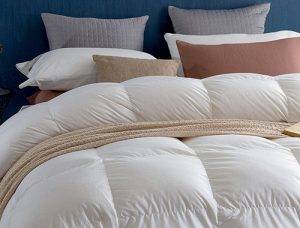 Baffle stitching means that the comforter is made from compartments designed to hold the fill, whilst a separate material piece connects the top and bottom side. The fill will have enough space to move inside the compartments, which means that these comforters have higher loft, even if they so require more frequent fluffing.
Baffle stitching means that the comforter is made from compartments designed to hold the fill, whilst a separate material piece connects the top and bottom side. The fill will have enough space to move inside the compartments, which means that these comforters have higher loft, even if they so require more frequent fluffing.